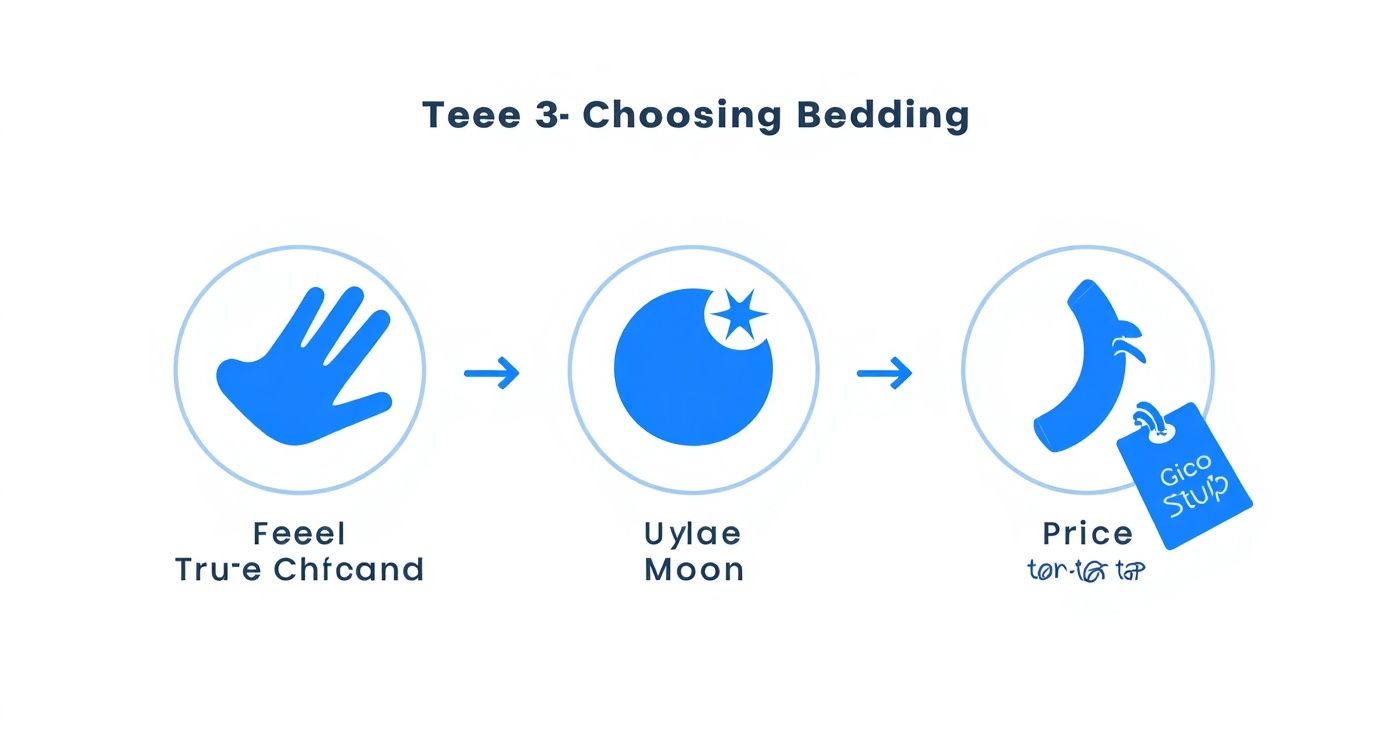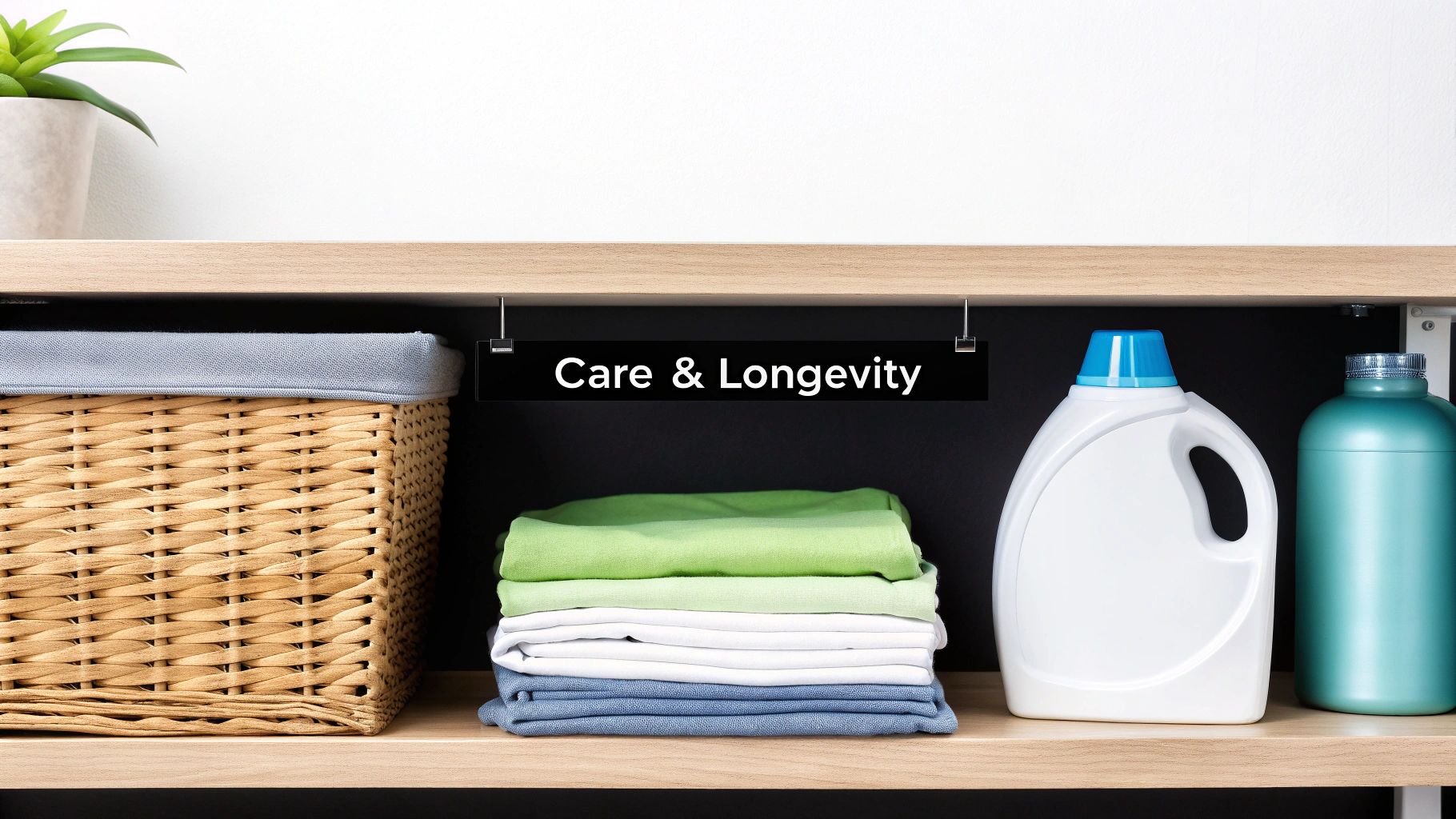Finding the best bedding NZ has to offer is all about matching materials to your personal sleep style and, of course, our unique Kiwi climate. It’s no surprise that natural fibres like linen and wool are often the go-to choices; their breathability and all-season comfort are hard to beat. This guide is here to make that choice a whole lot easier, helping you find beautiful, quality bedding that genuinely improves your sleep.
Your Guide to Choosing Ideal Bedding in New Zealand
Let's be honest, hunting for the perfect bedding in New Zealand can feel a bit overwhelming. You've got everything from local artisan brands to big international retailers, and it's easy to get lost in a maze of different fabrics, weaves, and flashy marketing claims. The goal here is to cut through all that noise and focus on what really matters for creating a sleep sanctuary in your Kiwi home.
We'll look at how New Zealand's famously varied climate—from those humid summers up north to the crisp, frosty winters down south—plays a big part in choosing the right material. You’ll also see why so many people are turning to natural, sustainable fibres. Think of this guide as your starting point for making a smart, confident investment in your own comfort.
Why Quality Bedding Matters
Great bedding is so much more than a finishing touch for your bedroom decor; it's a vital part of getting a truly restorative night's sleep. The right materials do some serious heavy lifting—they help regulate your body temperature, wick away moisture, and feel incredibly soft and soothing against your skin.
If you're after the absolute best in comfort and something that will last for years, it's well worth exploring options like luxury linen in NZ. It really highlights the difference that investing in premium materials can make.
The demand for high-quality home furnishings here is strong, which means the local market is buzzing with competition and innovation. In fact, the furniture retailing industry in New Zealand, which includes bedding, is on track to hit a market size of $1.5 billion by 2025. This growth is driven by our expanding population and housing market, which is great news for us as consumers—it means more choice and better quality. You can check out more details about the NZ furniture retail market on IBISWorld.
Investing in high-quality bedding is an investment in your well-being. It transforms your bedroom into a true retreat, promoting better sleep and enhancing your daily life.
To get you started, the table below gives a quick snapshot of the most popular materials you'll find. It’s a great way to familiarise yourself with the basics before we dive into the finer details of each one.
Quick Comparison of Popular NZ Bedding Materials
Use this summary to quickly compare the key features of common bedding materials and find the right fit for your sleep style.
| Material | Best For | Feel | Typical Price |
|---|---|---|---|
| Linen | All-season comfort, hot sleepers, and a relaxed look. | Crisp but gets softer with every wash. Highly breathable. | $$$ (Premium) |
| Cotton | Everyday use, versatility, and a crisp, clean feel. | Varies by weave (percale is crisp, sateen is silky). | $$ (Mid-range) |
| Wool | Winter warmth and natural temperature regulation. | Cosy, weighty, and naturally insulating. | $$-$$$ (Varies) |
| Bamboo | Sensitive skin, eco-conscious buyers, and a silky feel. | Extremely soft, smooth, and drapes beautifully. | $$ (Mid-range) |
This table is just the beginning, of course. Now, let's take a closer look at what makes each of these materials unique and which one might be the perfect match for you.
Matching Bedding Materials to the NZ Climate
Choosing the right bedding material in New Zealand is about so much more than just picking a colour you like. It’s about getting smart with our famously unpredictable climate. Think of your bedding as your own personal climate-control system, one that needs to handle everything from a muggy Northland summer night to a crisp, frosty morning down south. The secret is finding a natural fibre that works with you, not against you.
This decision-making process is all about finding the perfect sweet spot between feel, function, and your budget.

This handy visual guide breaks down the choice by focusing on what you personally prefer, steering you towards the ideal material for a perfect night's sleep.
Breathable Fibres for Warmer Nights
For those sticky coastal summers or the height of a classic Kiwi heatwave, breathability isn't just nice to have—it's essential. This is where materials like linen and certain cotton weaves really come into their own.
- Linen: Often hailed as the ultimate choice for anyone who sleeps hot, linen is a champion of breathability and moisture-wicking. Its natural, hollow fibres let air move freely, creating a noticeable cooling effect that feels incredible on a warm night. Want to know more? We explain exactly how linen keeps you cool and sweat-free in our detailed guide.
- Cotton Percale: If you adore that crisp, cool feeling of high-end hotel sheets, then percale is your answer. It's made with a simple, one-over-one-under weave, which results in a light, airy fabric that stays cool to the touch. It’s a timeless classic for a very good reason.
On the other hand, you have cotton sateen, which has a much denser, silkier weave. While it feels incredibly soft and luxurious, it also traps more heat, making it a better fit for the cooler months or for people who don't tend to overheat.
Insulating Materials for Colder Seasons
When the temperature really starts to drop, you need bedding that provides genuine warmth without making you feel clammy and overheated. This is where New Zealand's own hero fibre truly shines.
Merino Wool: Unmatched in its ability to regulate temperature, Merino wool is a Kiwi icon for a reason. Its incredibly fine fibres create thousands of tiny air pockets that trap your body heat for insulation. Yet, it's also brilliantly breathable, wicking moisture away to stop you from ever feeling damp.
This natural high-performance quality is a huge driver in our local market. In fact, New Zealand's home bedding industry is forecast to grow at a steady compound annual growth rate of about 6.4% between 2025 and 2035. This growth is largely thanks to Kiwis' strong preference for locally made, sustainable, and wool-based products that are perfectly suited to our unique climate.
Versatile Options for Year-Round Comfort
Some materials strike a fantastic balance, making them great all-rounders for year-round comfort across most of the country. Bamboo is a standout here, loved for its silky-soft feel and impressive temperature-regulating abilities.
To really nail your choice, it pays to get into the details of these popular fabrics. For instance, you can check out a comparison of bamboo and Tencel fabrics to see how they stack up against each other. Ultimately, matching the material to where you live and how you sleep is the real key to finding the best bedding NZ has to offer.
What Really Matters More Than Thread Count
For years, we've been told that a high thread count is the ultimate sign of luxury bedding. But honestly, that’s one of the biggest myths in the industry. It's a bit like judging a camera purely on its megapixels; a huge number means nothing if the lens is rubbish.
In bedding, the "lens" is the quality of the fibre itself. Many manufacturers inflate their thread counts by using thin, weak, multi-ply threads. These might look good on the packaging, but they wear out quickly and never feel as good as they should.
True luxury isn’t about cramming as many threads as possible into a square inch. It’s about the quality of the raw materials from the very beginning. The real markers of incredible bedding are the length of the fibre, the strength of the yarn, and the type of weave. These three elements are what create sheets that are soft, durable, and breathable – everything you want when you’re looking for the best bedding NZ has to offer.

The Quality of the Fibre
The single most important factor, hands down, is the quality of the raw fibre. Long-staple cottons, like authentic Egyptian or Supima®, produce yarns that are incredibly strong, smooth, and fine. Because these long fibres are less likely to pill or break, they result in sheets that actually get softer and more beautiful over time.
On the flip side, short, brittle fibres create coarse yarns that can feel rough and wear down fast, no matter how high the thread count is. If you're after true, lasting comfort, investing in bedding made from long-staple fibres is the first and most important step.
How the Weave Changes Everything
Once you have beautiful, high-quality yarn, the weave is what determines the final feel and performance of the fabric. The two most common weaves you’ll come across are percale and sateen, and they couldn’t feel more different.
- Percale Weave: Think of a simple, grid-like pattern: one-thread-over, one-thread-under. This creates a fabric that is light, crisp, and incredibly breathable. It feels wonderfully cool against the skin, making it perfect for hot sleepers or those humid Kiwi summers.
- Sateen Weave: This weave uses a different pattern, typically one-thread-under and three-or-four-threads-over. By exposing more of the thread's surface, you get a silkier, smoother feel with a lovely, subtle sheen. Sateen is a little heavier and warmer than percale, making it a cosy choice for cooler nights.
The weave is the architecture of your sheets. Percale builds an airy, cool structure, while sateen creates a smooth, draping sanctuary. Choosing the right one is about deciding what kind of comfort you want to come home to.
At the end of the day, a 300 thread count sheet made from top-quality, long-staple cotton with a beautiful percale weave will feel far more luxurious—and last much longer—than an 800 thread count sheet made from cheap, inferior fibres. To dig deeper into this common marketing tactic, check out our complete guide on why you can't always trust high thread count sheets.
Discovering Top New Zealand Bedding Brands
https://www.youtube.com/embed/6j3gS2A-UfU
Navigating the world of New Zealand bedding can feel like a journey in itself. We're lucky to have a fantastic mix of local artisans, luxury boutiques, and trusted household names right on our doorstep. The secret to finding the best bedding NZ has to offer is knowing where to look and what you truly value—whether that’s sheer opulence, sustainable practices, or just good old-fashioned comfort.
To make things a bit easier, I've broken down some of the country’s leading brands and retailers into a few key categories. Think of this less as a list and more as a curated guide to help you find the perfect match for your home.
It's worth noting the local market has seen some big shifts recently. In 2024, the New Zealand bed linen market experienced a significant contraction, shrinking by about 93.1% from the previous year to a value of around $10 million. While that number looks dramatic, it highlights just how much consumer habits are changing and proves the resilience of those top-tier brands that stick to their guns on quality and craftsmanship. You can dig into more of the data behind NZ bed linen market trends on IndexBox.io.
The Luxury Investment
For some of us, bedding is a true long-term investment in our own comfort and well-being. If that sounds like you, a handful of New Zealand brands truly stand out from the crowd. These are the companies specialising in premium materials like authentic French flax linen or buttery-soft, long-staple cotton, with a focus on craftsmanship that’s built to last.
- Who they're for: Anyone who prioritises that exceptional, next-level feel and wants bedding that will endure for years.
- What to expect: A higher price point, but one that reflects the superior quality of the raw materials and the artistry involved.
- Examples: Brands like The Foxes Den and Wallace Cotton are renowned for their beautiful collections of luxurious linen and high-thread-count cotton, often with a timeless, elegant aesthetic.
When you invest in luxury bedding, you are buying more than just sheets. You are buying a nightly experience defined by superior comfort, breathability, and enduring quality that often improves with age.
The Eco-Conscious Choice
For a growing number of Kiwi households, sustainability isn't just a buzzword—it's a priority. Thankfully, several local brands have built their entire mission around this ethos. These are the companies championing organic materials, ethical production, and environmentally friendly processes from the farm to your bedroom.
When you're shopping, keep an eye out for certifications like GOTS (Global Organic Textile Standard) or Fair Trade. These aren't just marketing fluff; they're your assurance that a brand's green claims are backed by real, verifiable action. You'll find they often work with materials like organic cotton, bamboo, or Tencel™, all of which have a much smaller environmental footprint.
The Everyday Comfort
Let's be honest, sometimes you just need reliable, great-quality bedding that feels fantastic without costing a fortune. This is where New Zealand's major retailers and established brands really shine, offering a huge range of accessible, dependable options.
These retailers are perfect for outfitting the whole family, grabbing a durable set for the guest room, or finding easy-care sheets that can handle the rigours of daily life. You'll find a massive selection of materials, from crisp cotton percale for summer to cosy flannelette for those chilly winter nights, making them a practical and dependable route to a comfortable night's sleep.
How to Care for Your Bedding and Make It Last
You’ve invested in beautiful, high-quality bedding, and that’s one of the best moves you can make for a great night’s sleep. But to make sure that investment pays off for years, a little care goes a long way. Think of it less as a chore and more as a ritual to protect the softness, colour, and feel of the fabrics you love.
Following the right steps doesn't just keep your sheets clean; it actively preserves their luxurious touch and extends their lifespan. With a few simple tweaks to your laundry routine, you can keep premium materials like linen, cotton, and wool feeling incredible.

Washing Your Bedding Correctly
The golden rule for washing luxury bedding? Be gentle. Harsh detergents, high heat, and an overcrowded machine are the biggest enemies of fine fabrics, causing them to wear out far too soon.
Always reach for a mild, liquid detergent. Powdered versions can sometimes leave a gritty residue, while those with whiteners or brighteners often contain chemicals that are too harsh for natural fibres.
Treat your bedding like you would a favourite piece of clothing. A gentle cycle with cool or warm water—never hot—is the safest bet. This simple step protects the fibres from shrinking and helps keep their colours rich and true.
Of course, knowing how to wash is only half the battle. If you're wondering about frequency, this guide on how often to wash bedding is a fantastic resource.
Drying Techniques for Longevity
How you dry your sheets is just as critical as how you wash them. While the convenience of a tumble dryer is tempting, high heat can be incredibly damaging to delicate fabrics like linen and long-staple cotton.
If you have the option, line drying is the absolute best method. There’s nothing quite like the fresh air and sunshine to naturally freshen your sheets, and it’s the gentlest way to dry them without any risk of heat damage. Making the most of a sunny New Zealand day is the ideal way to care for your bedding.
If you need to use a dryer, here’s how to do it right:
- Stick to a low heat setting. This prevents the fibres from becoming brittle and breaking over time.
- Don't over-dry them. Pull your bedding out when it's still slightly damp to help prevent wrinkles and lock in that softness.
- Toss in some wool dryer balls. They're a brilliant, natural alternative to dryer sheets. They soften fabrics and reduce static without any chemicals.
Here's a common myth we need to bust: fabric softener isn't your friend. Liquid softeners and dryer sheets coat natural fibres in a waxy film. This residue actually reduces the breathability and absorbency of materials like linen and cotton—the very qualities you paid for! To keep your bedding feeling soft and luxurious for the long haul, it's best to skip the softener completely.
Common Questions About Finding the Best Bedding in NZ
Choosing the right bedding can feel like a big decision, and it’s completely normal to have a few questions before you commit. To help you feel confident in your choice, we’ve pulled together some of the most common things Kiwis ask when they’re on the hunt for the perfect sheets, duvets, and pillows.
Think of this as a quick-fire round to clear up any lingering doubts. Getting it right means you’ll get so much more value and comfort from your new bedding, so let’s get into the details that really matter.
What Is the Best Bedding for Hot Sleepers in NZ?
If you’re someone who tends to run hot at night—especially during those sticky Northland summers or even in a well-insulated new build—the key is breathability.
Your best bet will always be natural fibres. Here are the top contenders:
- Linen: Hands down, linen is the champion for hot sleepers. The hollow flax fibres create incredible airflow and are brilliant at wicking moisture away from your skin, which has a genuine cooling effect. It's an investment, but one you'll appreciate every single night.
- Cotton Percale: If you love that crisp, cool-to-the-touch feeling you get from hotel sheets, percale is your friend. Its simple, one-over-one-under weave is light and airy, stopping heat from getting trapped around you.
The materials to steer clear of are synthetics and high-sheen sateen weaves. Both are notorious for trapping heat, which is the last thing you want when you’re trying to get a restful night's sleep.
Is a High Thread Count Always Better?
Absolutely not. This is probably the biggest and most stubborn myth in the bedding world. While thread count isn't completely irrelevant, it's a long way from being the most important factor.
Think of it like this: a high thread count made from poor-quality, short fibres is like a blurry photo taken on a high-megapixel camera. The number sounds impressive, but the final result is disappointing. True luxury comes from the quality of the raw materials, not just cramming more threads in.
Instead, shift your focus to what actually makes a difference:
- Fibre Quality: Look for long-staple cottons (like Supima® or Egyptian) or high-grade flax for linen. Longer fibres create yarns that are stronger, smoother, and far more durable.
- Weave Type: As we’ve covered, the weave is what really dictates how the fabric feels. A percale weave is crisp and cool; a sateen weave is silky and warmer.
A 300-thread-count sheet made from premium long-staple cotton will feel infinitely better and last much longer than an 800-thread-count sheet made from cheap, short-staple cotton.
How Often Should I Really Replace My Bedding?
There's no single, hard-and-fast rule here, because the lifespan of your bedding really depends on the quality of the material and how you care for it. But there are definitely some tell-tale signs that it’s time for an upgrade.
You should think about replacing your bedding when you start to notice:
- Visible Wear and Tear: This could be fabric that feels noticeably thin, frayed edges, stubborn little bobbles (pills), or even small holes.
- Permanent Stains or Discolouration: That yellowish tinge on white sheets that just won’t wash out is a classic sign they’re past their prime.
- Loss of Softness: If your once-buttery-soft sheets now feel rough or scratchy against your skin, it means the fibres have started to break down.
As a rough guide, top-quality linen can last for years (sometimes even decades!) and just gets better with age. A good set of mid-range cotton sheets will likely give you 2-3 years of service. And for hygiene and support, you should aim to replace your pillows every 1-2 years.
Are Linen Sheets Worth the Investment for the NZ Climate?
For the vast majority of us here in New Zealand, the answer is a resounding yes. Linen's natural properties make it almost perfectly designed for our changeable climate.
Its incredible ability to regulate temperature means it keeps you cool and dry during humid summers, but also provides a comfortable, breathable warmth on those colder winter nights. This all-season performance makes it an incredibly practical choice.
And while the initial cost is higher, its remarkable durability means a single set of quality linen can easily outlast several sets of cheaper sheets. In the long run, it’s a smart investment in your sleep and comfort.
At The Foxes Den, we believe that beautiful, high-quality bedding is the foundation of a truly comfortable home. Our curated collection of luxury linen and Supima® cotton is designed to bring timeless elegance and exceptional comfort to your bedroom. Explore our range to find the perfect pieces for your sleep sanctuary.


